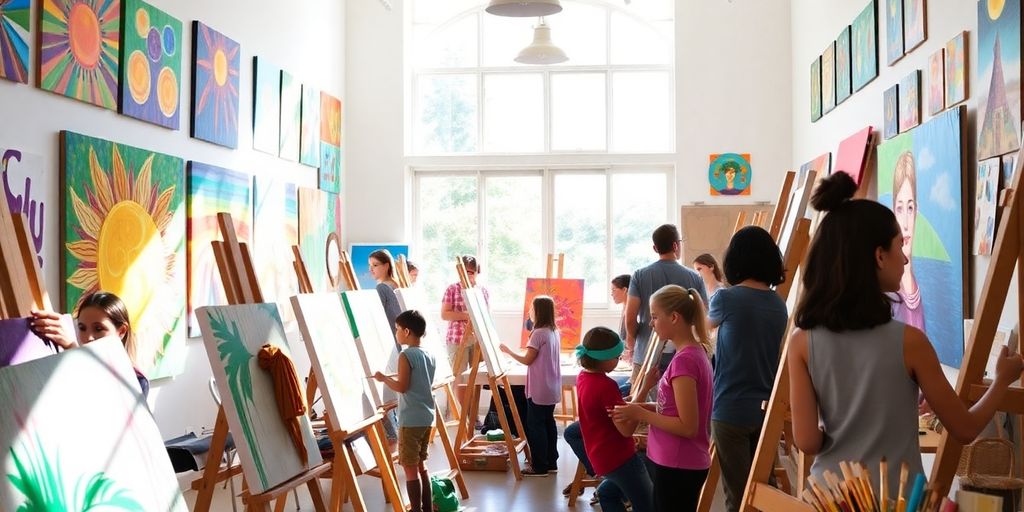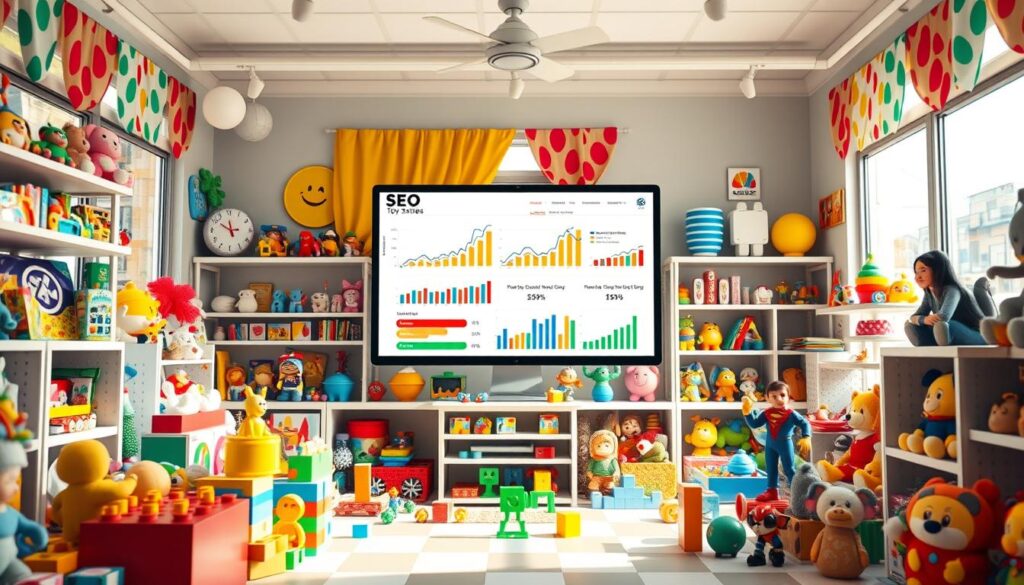So you’re running art classes and wondering how to get more people to find you online? That’s where SEO, or search engine optimization, comes into play. It’s not just for tech gurus—it’s something art instructors can use too. By understanding and implementing SEO strategies, you can make your art classes more visible to potential students searching online. Let’s dig into how you can make SEO work for your art classes.
Key Takeaways
- SEO helps art classes become more visible online, attracting more students.
- Using high-quality images and videos can boost your site’s appeal and SEO.
- Social media platforms are essential for promoting your art classes and engaging with potential students.
- Choosing the right keywords is crucial for driving traffic to your website.
- Monitoring your SEO performance helps you adjust strategies and improve results.
Understanding SEO for Art Classes
Defining SEO in the Art Context
SEO, or Search Engine Optimization, is all about making sure your art classes are easy to find online. In the art world, this means using keywords and strategies that highlight your classes, making them pop up when someone searches for art classes in your area or specialty. It’s not just about getting traffic; it’s about attracting the right audience who are genuinely interested in what you offer.
Importance of SEO for Art Instructors
For art instructors, SEO is like having a signpost on a busy street. Without it, your classes might get lost in the digital noise. SEO helps you reach potential students who might not find you otherwise. It’s crucial for filling up your classes and expanding your reach beyond word-of-mouth. With the right SEO tactics, you can turn casual browsers into committed students.
Common SEO Misconceptions
Many art instructors think SEO is all about stuffing keywords into their content. But it’s more than that. Effective SEO involves understanding what your audience is searching for and delivering content that meets those needs. Another misconception is that SEO is a one-time task. In reality, it requires ongoing effort to keep up with changes in search engine algorithms and trends. Avoid these pitfalls to ensure your SEO efforts are truly effective.
Utilizing Visual Content Effectively
The Power of High-Quality Images
High-quality images can make or break your art class’s online presence. Images don’t just decorate your page; they tell your story. When potential students browse, they want to see vibrant and clear visuals that capture the essence of what you teach. Here’s how to make the most of your images:
- Descriptive File Names: Instead of generic titles like ‘IMG1234.jpg,’ use descriptive names such as ‘watercolor-techniques-class.jpg.’
- Alt Text: This is crucial for accessibility and SEO. Describe your images in detail to help search engines and visually impaired users understand them.
- Proper Sizing and Compression: Ensure images are high-quality but optimized for fast loading. This balance keeps your site looking professional without sacrificing speed.
Incorporating Videos into Your Strategy
Videos are a fantastic way to engage potential students. They offer a dynamic way to showcase your teaching style and the atmosphere of your classes. Here’s how to integrate them effectively:
- Tutorials and Demos: Short clips of your teaching methods can give students a taste of what to expect.
- Student Testimonials: Capture the experiences and successes of your students to build trust and credibility.
- Behind-the-Scenes: Show the preparation and creativity that goes into your classes, making them more relatable and engaging.
Creating Engaging Visuals for Social Media
Social media is a powerful tool for promoting art classes. Creating visuals that catch the eye can lead to more engagement and interest in your classes. Here are some tips:
- Consistency: Use a consistent style and color palette to make your posts recognizable.
- Interactive Content: Polls, quizzes, and Q&A sessions can make your content more engaging.
- Storytelling: Use visuals to tell a story about your classes, projects, or student journeys.
Engaging visuals are not just about aesthetics; they’re about creating a connection. When your visuals resonate, they draw people in, inviting them to explore what you offer.
Leveraging Social Media for SEO
Choosing the Right Platforms
Picking the right social media platforms is like choosing the right paintbrush for a masterpiece. Not every platform will suit your art class needs. Facebook is great for community building, Instagram is perfect for visual storytelling, and Pinterest can drive traffic with its visual search capabilities. Each platform offers unique benefits, so understanding your target audience’s preferences is key. Consider where your potential students spend their time online and focus your efforts there.
Engaging with Your Audience
Engagement is more than just replying to comments. It’s about creating a conversation around your art classes. Ask questions, run polls, and encourage feedback. This interaction not only builds a community but also boosts your visibility in social algorithms. Here are some tips to keep your audience engaged:
- Post regularly but don’t spam.
- Share behind-the-scenes content to make your classes relatable.
- Use stories and live sessions for real-time interaction.
Promoting Art Classes through Social Media
Promotion on social media should feel natural and not overly salesy. Share success stories from past students or showcase upcoming class projects. Highlighting the unique aspects of your classes can pique interest. Consider collaborating with influencers or other artists to expand your reach.
Social media isn’t just about being seen; it’s about being remembered. By enhancing your online art business through strategic social media use, you can create lasting impressions that translate into student enrollments.
Building a Strong Keyword Strategy

Identifying Relevant Keywords
When you’re trying to get noticed online, picking the right keywords is like choosing the perfect paint color for your masterpiece. It’s all about knowing what your audience is searching for. Start by thinking about the words and phrases people might use when looking for art classes. Maybe it’s "beginner watercolor classes" or "advanced oil painting techniques." The goal is to be specific—you don’t want to get lost in a sea of generic terms like "art." Use tools like Ubersuggest or Google Keyword Planner to see what people are actually typing into search engines. This can give you a better idea of which keywords have a good search volume and aren’t too competitive.
Using Keywords in Content Creation
Once you’ve got your list of keywords, it’s time to weave them into your content. This isn’t just about stuffing keywords wherever you can; it’s about making them fit naturally. Think about your blog posts, class descriptions, and even your "About" page. For instance, if "watercolor techniques for beginners" is one of your keywords, you might write a blog post about the top five techniques every beginner should know. Remember, your content should be helpful and engaging, not just a list of keywords.
Monitoring Keyword Performance
Keeping an eye on how your keywords are performing is crucial. You don’t want to spend time focusing on keywords that aren’t bringing in any traffic. Use tools like Google Analytics to see which keywords are driving visitors to your site. If something’s not working, don’t be afraid to tweak your strategy. Maybe a keyword isn’t as popular as you thought, or perhaps there’s a new trend you can tap into. Regularly reviewing your keywords can help keep your strategy fresh and effective.
Crafting a keyword strategy is like creating a piece of art—it’s all about balance and knowing your audience. Stay flexible and keep refining your approach to see the best results.
By focusing on a strong keyword strategy, you can help ensure that your art classes are not just seen, but found by those who are truly interested. For more tips on boosting your online presence, check out 17 essential SEO tips to increase your Google rankings.
Enhancing Local SEO for Art Classes

Optimizing for Local Search Terms
When it comes to art classes, attracting local students is often key. To do this, make sure your website is optimized for local search terms. Include the name of your city or region in your keywords and throughout your website content. This helps search engines connect your classes with people searching for art education in your area. Additionally, ensure your location is clearly mentioned on your website, including a map if possible.
Utilizing Google My Business
Setting up a Google My Business profile is a must for any local business. This free tool allows you to manage how your art classes appear on Google Search and Maps. Make sure to fill out all the details, like your address, phone number, and business hours. Encourage students to leave reviews, as positive feedback can boost your visibility. Regularly update your profile with photos of your classes and any special events or promotions.
Encouraging Customer Reviews
Reviews can make a big difference in how potential students perceive your art classes. Encourage your current students to leave honest reviews online. You can do this by sending a follow-up email after classes or offering a small incentive. Positive reviews not only improve your search engine rankings but also build trust with new students. Remember, even negative reviews can be an opportunity if you handle them professionally and use them to improve your services.
Being visible in local searches is like having a signpost in your neighborhood that says "art classes here!" It draws in those nearby who are looking for what you offer, making it easier for them to find and join your classes.
Creating High-Quality Content
Blogging About Art Techniques
Writing about art techniques can be a fantastic way to engage both students and potential clients. Sharing your insights on various methods not only showcases your expertise but also helps in building a community of art enthusiasts. Consider writing about different styles, tools, and mediums. For example, a post on watercolor techniques could include tips on brush handling, color blending, and paper selection.
Sharing Student Success Stories
Highlighting your students’ achievements can be a powerful marketing tool. It not only boosts their confidence but also shows potential students the value of your classes. Create a regular feature on your blog or newsletter where you share stories of student progress and success. This could include interviews, before-and-after images of their work, or even short video testimonials.
Offering Art Tips and Resources
Providing valuable resources and tips can keep your audience coming back for more. Compile a list of essential art supplies, or create guides on setting up a home studio. You could also offer advice on improving drawing skills or mastering perspective.
Consistent, high-quality content is the backbone of effective SEO strategies for schools, as it draws traffic and encourages longer site visits, which are crucial for improving search engine rankings.
Remember, the key is to keep your content relevant and useful. By doing so, you’ll not only improve your SEO but also build a loyal following.
Monitoring and Analyzing SEO Performance
Using SEO Tools for Tracking
Keeping tabs on your SEO efforts is like keeping an eye on a garden; you need to know what’s growing and what needs more attention. Tools like GA4 offer a range of features to help you track how your website is doing in search engines. By monitoring web traffic and search performance, you can make informed decisions about what content works and what doesn’t. This tracking helps you see which keywords bring in the most visitors and where you might need to tweak your strategy.
Understanding SERP Features
Knowing how your art classes appear on search engine results pages (SERPs) is vital. SERP features like snippets, local packs, and reviews can significantly impact your visibility. Analyzing these elements helps you understand what catches the eye and what might be missing. By aligning your content with these features, you can improve your chances of standing out in search results.
Adjusting Strategies Based on Data
Data is your best friend when it comes to SEO. Once you’ve gathered insights from tools and SERP analysis, it’s time to act. Here are some steps to consider:
- Identify which keywords are underperforming and adjust your content strategy accordingly.
- Look at the pages with the highest bounce rates and think about how to make them more engaging.
- Regularly update your strategy based on the latest data to stay ahead of trends.
Monitoring SEO isn’t just about numbers; it’s about understanding the story behind those numbers. By consistently analyzing and adjusting, you ensure your art classes remain visible and accessible to potential students.
Conclusion
So, there you have it. SEO for art classes might sound a bit techy, but it’s really about getting your classes noticed online. Think of it like setting up a signpost in the digital world, pointing folks to your amazing art sessions. By using the right keywords, sharing cool visuals, and keeping your website in tip-top shape, you’re making it easier for people to find you. And let’s not forget social media—it’s your best friend in spreading the word. Sure, it takes a bit of effort, but the payoff is worth it. More students, more buzz, and a thriving art community. So, why not give it a shot? Your art classes deserve to shine!
Frequently Asked Questions
What is SEO and why is it important for art classes?
SEO, or Search Engine Optimization, is the process of improving your website so that it ranks higher in search engine results. For art classes, this means more people can find your classes online, which can lead to more students enrolling.
How can I use social media to boost my art class website?
Social media is a great way to share your art classes and connect with potential students. By posting regular updates, engaging with your followers, and sharing high-quality images and videos, you can drive more traffic to your website.
What are some common mistakes to avoid with SEO for art classes?
Some common mistakes include using too many keywords, ignoring local SEO, and not optimizing images. It’s important to have a balanced approach and focus on providing valuable content.
How do I choose the right keywords for my art class website?
Start by thinking about what words people might use to find your classes. Use tools to see how often these words are searched and choose ones that are relevant and have a good search volume.
Why is local SEO important for art classes?
Local SEO helps people in your area find your classes. By optimizing for local search terms and using tools like Google My Business, you can attract more local students.
What kind of content should I create for my art class website?
Create content that showcases your expertise, like blog posts about art techniques, student success stories, and tips for aspiring artists. This helps build trust and attracts more visitors to your site.






